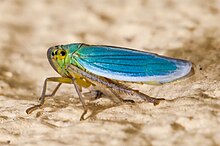Cicadella viridis: Difference between revisions
No edit summary |
No edit summary |
||
| Line 20: | Line 20: | ||
==Description== |
==Description== |
||
[[File:Binsenschmuckzikade Larve, Cicadella viridis 2.JPG|thumb|200px|left|Nymph of ''Cicadella viridis'']] |
[[File:Binsenschmuckzikade Larve, Cicadella viridis 2.JPG|thumb|200px|left|Nymph of ''Cicadella viridis'']] |
||
[[File:Ficheiro-Araña alimentándose de Auchenorrhyncha. Bastavales, Brión, 090905.jpg||thumb|200px|left|''[[Parasteatoda tepidariorum]]'' and Cicadella viridis]] |
|||
The adults reach {{convert|6|-|9|mm}} of length, but the females are quite larger than the males. Adult leafhoppers can mostly be encountered from July through October in wet meadows, near marshes or in swampy habitats, but sometimes live also in drier areas. |
The adults reach {{convert|6|-|9|mm}} of length, but the females are quite larger than the males. Adult leafhoppers can mostly be encountered from July through October in wet meadows, near marshes or in swampy habitats, but sometimes live also in drier areas. |
||
Revision as of 17:01, 17 September 2015
| Cicadella viridis | |
|---|---|

| |
| Cicadella viridis, dorsal view | |
| Scientific classification | |
| Kingdom: | |
| Phylum: | |
| Subphylum: | |
| Class: | |
| Order: | |
| Family: | |
| Genus: | |
| Species: | C. viridis
|
| Binomial name | |
| Cicadella viridis | |
Cicadella viridis, the 'Green Leafhoppers', is a species of belonging to the family Cicadellidae subfamily Cicadellinae.
Description


The adults reach 6–9 millimetres (0.24–0.35 in) of length, but the females are quite larger than the males. Adult leafhoppers can mostly be encountered from July through October in wet meadows, near marshes or in swampy habitats, but sometimes live also in drier areas.
Their pronotum is green and yellow. The front head is pale yellow, with two black spots near the compound eyes. The forewings are turquoise green in the females, blue or dark bluish in males (sexual dimorphism).
They are polyphagous, feeding on the sap of various species of herbaceous plants, mainly Juncus (Juncaceae sp.), Carex (Cyperaceae sp.), Holcus (Poaceae sp.) and Fabaceae species.

The larvae are yellowish and have two brownish stripes running from head to the end of the abdomen. Cicadella viridis may have one or more generations per year. This species overwinters in the egg stage.
Distribution
This species is present in most of Europe, in eastern Palearctic ecozone, in the Near East, in the Nearctic ecozone, and in the Oriental ecozone.
References
- H. Nickel - The leafhoppers and plant hoppers of Germany (Hemiptera, Auchenorrhyncha) - Patterns and strategies in a highly diverse group of phytophagous insects - Pensoft, Sofia and Moskau 2003
